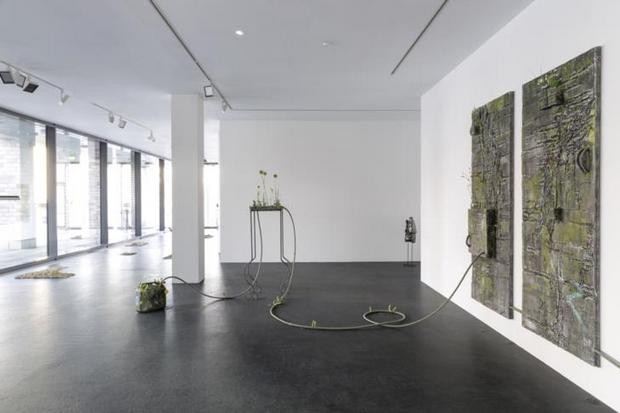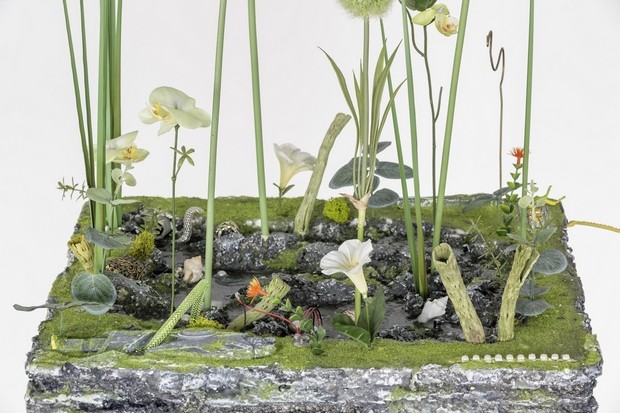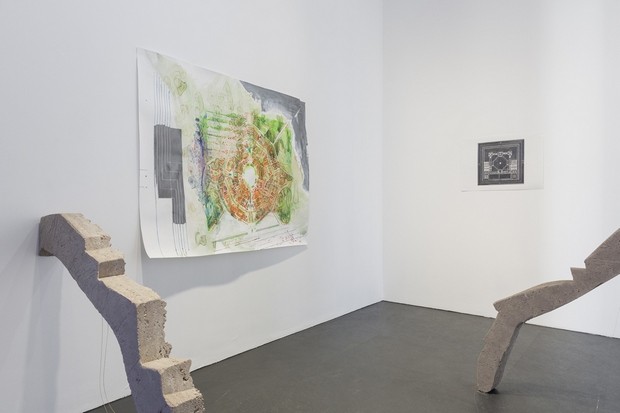Picknick am Wegesrand
05 Mar - 22 May 2016
PICKNICK AM WEGESRAND
Rochelle Goldberg, Tiril Hasselknippe, Veit Laurent Kurz, Martin Schepers, Raphaela Vogel, Phillip Zach
5 March - 22 May 2016
Facing global political situations defined by figures like Donald Trump in the USA, terrorism, or the refugee crisis, but also regarding the power of and the control through the media, the world we live in seems more fragile with each day that passes: there is no feeling of security anymore. In the light of the above, the digital and new technologies play a decisive role: they promise infinite and auguring possibilities, but at the same time they convey the impression of a growing menace.
The digital technologies seem to be salvation and catastrophe at the same time; in any case, we are at the brink of a new era, where new rules are created and the world is reorganised.Arkadi und Boris Strugazki‘s science fiction story ‘Roadside Picnic’, published in 1971, which inspired Andrei Tarkowski to the movie ‘Stalker‘ in 1979, offers a rather accurate summary of this period of upheaval. It tells a story about people being confronted with extraterrestrial and highly developed technology, with objects that were left by extraterrestrials after a visit to earth in particular. These objects embody menace as well as hope – a golden, globe-shaped object grants, so they say, any wish: a promise of salvation.
The exhibition ‘Roadside Picnic’ features drawings and sculptures of six young, contemporary artists which are interested in the fusion between nature and technology. The works by Rochelle Goldberg (*1984 in Vancouver, CA), Tiril Hasselknippe (*1984 in Arendal, NO), Veit Laurent Kurz (*1985 in Erbach, GER), Martin Schepers (*1979 in Lengerich, GER), Raphaela Vogel (*1988 in Nürnberg, GER) und Phillip Zach (*1984 in Cottbus, GER) interconnect through their haptic and sensual materiality, which deconstructs the smoothness of digital technology and transfer it back onto a human level.
Architecture and technology as places of surveillance and control, similar to a straitjacket, appear in the drawings by Martin Schepers as well as in the video sculpture Ohne Titel, 2016, by Raphaela Vogel, where a bird is trapped inside a TV screen. The Idealstadt Heimat, (transl. idealist hometown), thus the overall title of Martin Schepers‘ works, are of scientific nature, but at the same time, the pictures are characterised by smudged elements in black, bilious green and fiery red which give them an obscure touch. The eerie also finds itself in the hybrid figures between animal, human and machine by Raphaela Vogel: The type and usage of technical devices or digital technologies like a rear-seat screen or action cameras and the contents they broadcast transfer the digital into nature and also, nature becomes part of the digital. Ohne Titel appears like a strange, absurd everyday item, resembling an octopus. In the dystopic installation by Veit Laurent Kurz, the model-like nature produces its own ‘energy juice‘ through an integrated technology. The series Herba-U hints at a special power of radiance and potential as well as a certain risk. It remains an open question whether this merger poisons humans and nature or if they benefit from it. It remains enigmatic, what the glazed ceramic crocodiles by Rochelle Goldberg are meant to symbolise. The have been compressed, but their widely opened jaws still forcefully reach up, suggesting liveliness. Phillip Zach lays the floor with carpet pieces made of soil, plastic foam and litter. His works remind the viewer of a game of Tetris and forensic soil samples at the same time. Besides, they might just depict an archaeological proof of a roadside picnic and therefore radiate the feeling of a post-human age.
Rochelle Goldberg, Tiril Hasselknippe, Veit Laurent Kurz, Martin Schepers, Raphaela Vogel, Phillip Zach
5 March - 22 May 2016
Facing global political situations defined by figures like Donald Trump in the USA, terrorism, or the refugee crisis, but also regarding the power of and the control through the media, the world we live in seems more fragile with each day that passes: there is no feeling of security anymore. In the light of the above, the digital and new technologies play a decisive role: they promise infinite and auguring possibilities, but at the same time they convey the impression of a growing menace.
The digital technologies seem to be salvation and catastrophe at the same time; in any case, we are at the brink of a new era, where new rules are created and the world is reorganised.Arkadi und Boris Strugazki‘s science fiction story ‘Roadside Picnic’, published in 1971, which inspired Andrei Tarkowski to the movie ‘Stalker‘ in 1979, offers a rather accurate summary of this period of upheaval. It tells a story about people being confronted with extraterrestrial and highly developed technology, with objects that were left by extraterrestrials after a visit to earth in particular. These objects embody menace as well as hope – a golden, globe-shaped object grants, so they say, any wish: a promise of salvation.
The exhibition ‘Roadside Picnic’ features drawings and sculptures of six young, contemporary artists which are interested in the fusion between nature and technology. The works by Rochelle Goldberg (*1984 in Vancouver, CA), Tiril Hasselknippe (*1984 in Arendal, NO), Veit Laurent Kurz (*1985 in Erbach, GER), Martin Schepers (*1979 in Lengerich, GER), Raphaela Vogel (*1988 in Nürnberg, GER) und Phillip Zach (*1984 in Cottbus, GER) interconnect through their haptic and sensual materiality, which deconstructs the smoothness of digital technology and transfer it back onto a human level.
Architecture and technology as places of surveillance and control, similar to a straitjacket, appear in the drawings by Martin Schepers as well as in the video sculpture Ohne Titel, 2016, by Raphaela Vogel, where a bird is trapped inside a TV screen. The Idealstadt Heimat, (transl. idealist hometown), thus the overall title of Martin Schepers‘ works, are of scientific nature, but at the same time, the pictures are characterised by smudged elements in black, bilious green and fiery red which give them an obscure touch. The eerie also finds itself in the hybrid figures between animal, human and machine by Raphaela Vogel: The type and usage of technical devices or digital technologies like a rear-seat screen or action cameras and the contents they broadcast transfer the digital into nature and also, nature becomes part of the digital. Ohne Titel appears like a strange, absurd everyday item, resembling an octopus. In the dystopic installation by Veit Laurent Kurz, the model-like nature produces its own ‘energy juice‘ through an integrated technology. The series Herba-U hints at a special power of radiance and potential as well as a certain risk. It remains an open question whether this merger poisons humans and nature or if they benefit from it. It remains enigmatic, what the glazed ceramic crocodiles by Rochelle Goldberg are meant to symbolise. The have been compressed, but their widely opened jaws still forcefully reach up, suggesting liveliness. Phillip Zach lays the floor with carpet pieces made of soil, plastic foam and litter. His works remind the viewer of a game of Tetris and forensic soil samples at the same time. Besides, they might just depict an archaeological proof of a roadside picnic and therefore radiate the feeling of a post-human age.





